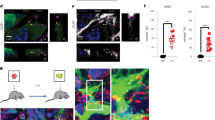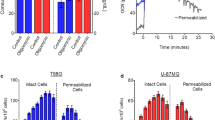Abstract
Recent studies have shown the mitochondria and mitochondrial DNA are altered in gliomas, studied either as primary tissues or in culture. Few studies have been performed which evaluate the mitochondria during the development of glial malignancy. We used an ethyl-nitrosourea (ENU) in vitro model to assess the changes in mitochondrial parameters with progression to astrocyte transformation. When compared to the untreated control cells mitochondrial mass of the ENU treated cells significantly decreased ontologically early with concurrent increase in mitochondrial membrane potential, resulting in hyperpolarization of the mitochondrial membrane. At successive divisions, the degree of spontaneous apoptosis during astrocyte transformation was significantly diminished in the ENU treated cells. With 24 h pre- and co-treatment of ENU cells with citrate, an allosteric inhibitor of phosphofructokinase, the astrocytes still became immortal, but did not manifest any of the mitochondrial changes nor acquire the transformed properties of the ENU treated cells without the inhibition. Indeed, the degree of apoptosis noted in these dually treated cells was increased, associated with a loss of anchorage independence and low density growth. Transformed subclones exposed to citrate after the development of malignant properties also exhibited increased apoptosis, and did not form colonies in low density plating conditions. These results suggest that the development of transformed properties in an ENU model is associated with marked hyperpolarization of mitochondrial membrane potential and diminished spontaneous apoptosis. Exposure to citrate attenuated these mitochondrial changes and in vitro growth properties, with increases in apoptosis. The development of transformed astrocytes involve constraints on apoptosis related to alterations in mitochondrial membrane potential and mass.
Similar content being viewed by others
References
Liang BC, Liang DM. Primary central nervous system neoplasms. In: Biller J, ed. Practical neurology. Philadelphia: Lippencott, 1997.
Grant R, Liang BC, Page M, Crane D, Greenberg H, Junck L. Age influences chemotherapy response in glioma, irrespective of tumor grade. Neurology 1995; 45: 929–933.
Cavalli LR, Liang BC. Mutagenesis, Tumorigenicity, and Apoptosis: Are the Mitochondria involved? Mutat Res 1998; 398: 19–26.
Kluck RM, Bossy-Wetzel E, Green DR, Newmeyer DD. The release of cytochrome c from mitochondria: a primary site for bcl-2 regulation of apoptosis. Science 1997; 275: 1132–1136.
Yang J, Liu X, Bhalla K, et al. Prevention of apoptosis by bcl-2: release of cytochrome c from mitochondria blocked. Science 1997; 275: 1129–1132.
Cavalli LR, Varella-Garcia M, Liang BC. Diminished Tumorigenic Phenotype after Depletion of Mitochondrial DNA. Cell Growth and Diff 1997; 8: 1189–1198.
Liang BC, Hays L. Mitochondrial DNA copy number alterations in human gliomas. Cancer Lett 1996; 105: 167–173.
Liang BC. Evidence for association of mitochondrial DNA sequence amplification and nuclear localization in human low-grade gliomas. Mutat Res 1996; 354: 27–33.
Oudard S, Poirson F, Miccoli L, et al. Mitochondria-bound hexokinase as target for therapy of malignant gliomas. Int J Cancer 1995; 62: 1–7.
Liang BC, Ullyatt E. Tryphostin AG17 chemosensitizes glioma cells to BCNU by a mitochondrially mediated mechanism. Clin Cancer Res 1998; 4: 773–782.
Lichtor T, Dohrmann GJ. Oxidative metabolism and glycolysis in benign brain tumors. Neurosurgery 1987; 67: 336–340.
Gonzalez-Mateos F, Gomez ME, Garcia-Salguero L, Sanchez V, Aragon JJ. Inhibition of glycolysis by amino acids in ascites tumor cells. J Biol Chem 1993; 268: 7809–7817.
Li J, Zhu X, Byrnes M, Nelson JW, Chang SH. Site-directed mutagenesis of rabbit muscle phosphofructokinase cDNA. Mutations at glutamine 200 affect the allosteric properties of the enzyme. J Biol Chem 1993; 268: 24599–24606.
Hiraga S, Arita N, Takanori O, et al. Transformation of Type 1 Astrocytes with N-Ethyl-N-Nitrosourea: Establishment of an In Vitro System and the Role of the p53 Gene. GLIA 1995; 13: 51–63.
Polla BS, Kantengwa S, Francois D, et al. Mitochondria are selective targets for the protective effects of heat shock against oxidative injury. Proc Natl Acad Sci USA 1996; 93: 6458–6463.
Maftah A, Petit JM, Ratinaud M-H, Julien R. 10-N Nonylacridine orange: a fluorescent probe which stains mitochondria independently of their energetic state. Biochem Biophys Res Commun 1989; 164: 185–190.
Liang BC. Effects of hypoxia on drug resistance phenotype and genotype in human glioma cell lines. J Neurooncol 1996; 29: 149–155.
Newell MK, Vander-Wall J, Beard KS, Freed JH. Ligation of MHC class II molecules mediates apoptotic cell death in resting B lymphocytes. Proc Natl Acad Sci USA 1993; 90: 10459–10463.
Sherwood SW, Schimke RT. Cell cycle analysis of apoptosis using flow cytometry. In: Schwartz LM, Osborne BA, eds. Cell death. New York: Academic Press 1995: 77–98.
Hayflick L, Moorhead PS. The serial cultivation of human diploid cell strains. Exp Cell Res 1961; 25: 585–621.
Zirvi KA, Masui H, Giuliani FC, Kaplan NO. Correlation of drug sensitivity on human colon adenocarcinoma cells grown in soft agar and in athymic mice. Int J Cancer 1983; 32: 45–51.
Andrews PA, Albright KD. Mitochondrial defects in cis-diamminedichloroplatinum (II)-resistant human ovarian carcinoma cells. Cancer Res 1992; 52: 1895–1901.
Liang BC, Ullyatt E. Increased sensitivity to cis-diamminedichloroplatinum-induced apoptosis with mitochondrial depletion. Cell Death and Diff 1998; 5: 694–701.
Schipper HM, Cisse S. Mitochondrial constituents of corpora amylacea and autofluorescent astrocytic inclusions in senescent human brain. GLIA 1995; 14: 55–64.
Norenberg MD, Mozes LW, Gregorios JB, Norenberg LO. Effects of lactic acid on astrocytes in primary culture. J Neuropathol Exp Neurol 1987; 46: 154–166.
Garland JM, A. H. Energy metabolism during apoptosis. J Biol Chem 1997; 272: 4680–4688.
Minn AJ, Velez P, Schendel SL, et al. Bcl-x(L) forms an ion channel in synthetic lipid membranes. Nature 1997; 385: 353–357.
Costello LC, Franklin RB. Bioenergetic theory of prostate malignancy. Prostate 1994; 25: 162–166.
Tornheim K, Andres V, Schultz V. Modulation by citrate of glycolytic oscillations in skeletal muscle extracts. J Biol Chem 1991; 266: 15675–15678.
Hayashi J, Takemitsu M, Nonaka I. Recovery of the missing tumorigenicity in mitochondrial DNA-less HeLa cells by introduction of mitochondrial DNA from normal human cells. Somatic Cell Mol Genet 1992; 18: 123–129.
Richter C, Schweizer M, Cossarizza A, Franceschi C. Control of apoptosis by the cellular ATP level. FEBS lett. 1996; 378: 107–110.
Shay JW. Cytoplasmic modification of nuclear gene expression. Mol Cell Biol 1983; 57: 17–26.
Israel BA, Schaeffer WI. Cytoplasmic suppression of malignancy. In Vitro Cell Dev Biology 1987; 23: 627–632.
Zinkewich-Peotti K, Parent M, Morais R. Mitochondrial DNA modulation of the anchorage-independent phenotype of transformed avian cells. Cancer Res 1990; 50: 6675–6682.
Author information
Authors and Affiliations
Rights and permissions
About this article
Cite this article
Liang, B.C., Miller, L. & Weller, A. Ethyl-nitrosourea transformed astrocytes exhibit mitochondrial membrane hyperpolarization and constrained apoptosis. Apoptosis 4, 89–97 (1999). https://doi.org/10.1023/A:1009610625150
Issue Date:
DOI: https://doi.org/10.1023/A:1009610625150




